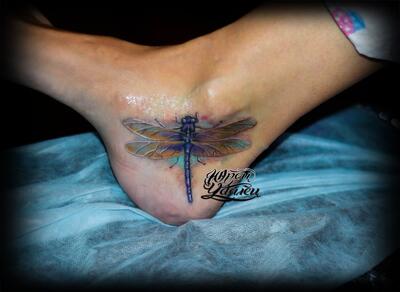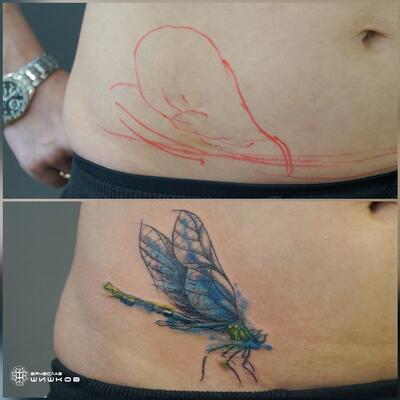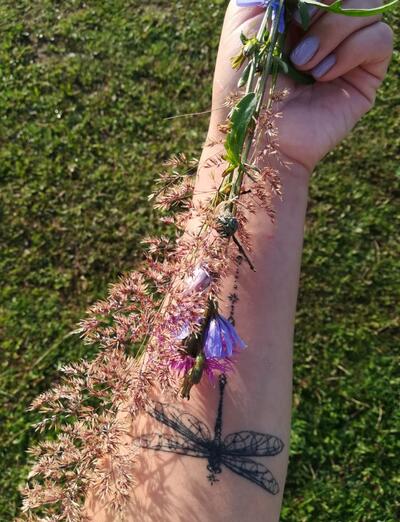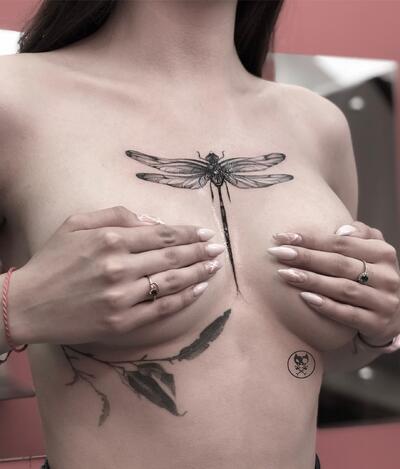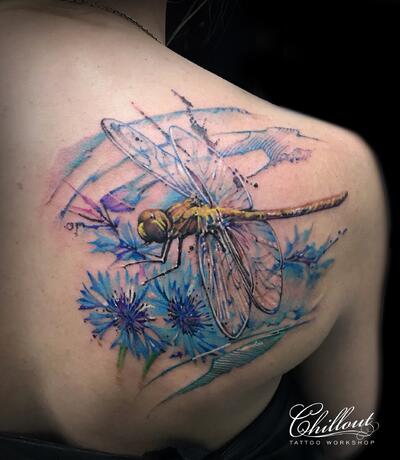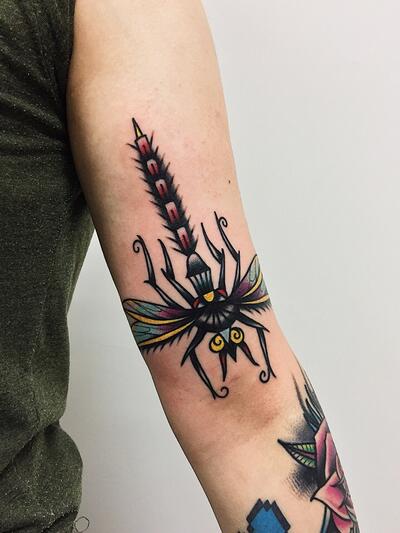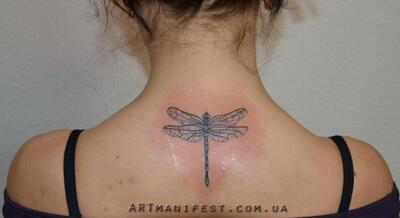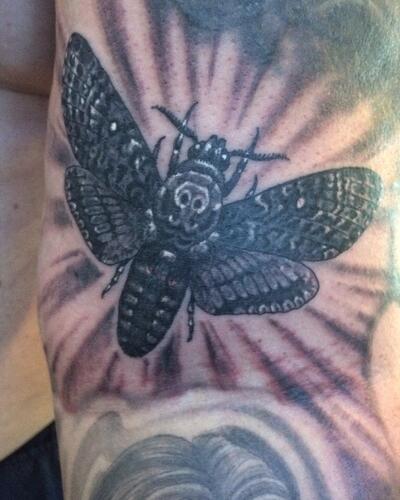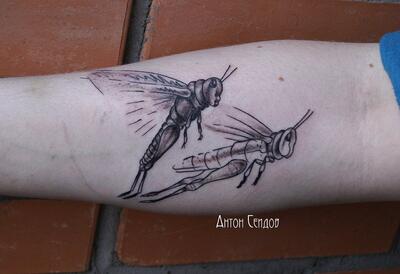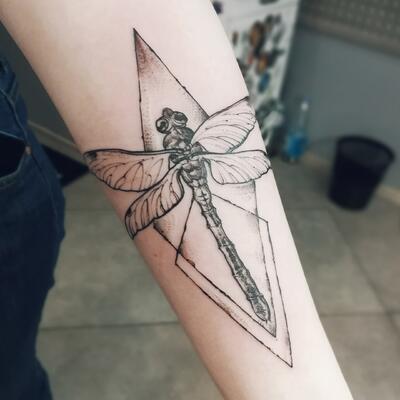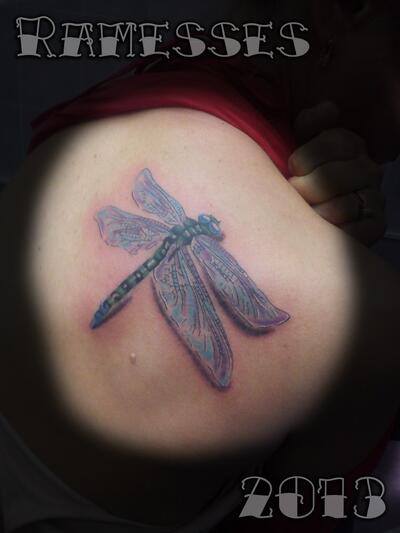Dragonfly tattoo: history, meaning and popular sketches.
The unusual appearance of the insect, as well as the ability of the dragonfly to hang in one place, after which it actually "disappears" from the field of view, made its image very statuesque. This was especially noticeable in African cultural traditions. Tattoos with an insect were usually worn only by the highest social strata, to which it is customary to refer the hereditary nobility, the priesthood and the military command.
For example, among the Egyptians, a tattoo with a dragonfly on the wrist of the left hand meant that the owner of the drawing was involved in the highest priestly caste, whose representatives were the only ones who had the right to touch the sacred figure of the "deity-pharaoh". And if, for example, the scarab was considered in ancient Egyptian culture as a "dark symbol" of the transition to the afterlife, then the meaning of a dragonfly tattoo could most often be interpreted as the birth and appearance of a new life.
The most noble and rich Egyptians specially ordered highly artistic dragonfly tattoos for concubine girls, or their daughters, when they were just getting married. Tattoos were usually done in the lower abdomen, under the navel or below. The image was interpreted as a protective symbol of fertility. It was believed that its owner was obliged to bear a particularly healthy and strong firstborn.
To the south, in African tribes, the image with a dragonfly was considered especially magical. In the form of body tattoos, only shamans, their students, and the strongest warriors (usually tribal leaders) could afford to wear it.
Oddly enough, but the almost identical situation in relation to the cult of the insect has developed in the Indian traditions of pre-Columbian America. The only difference is that people perceived such tattoos as a symbol of not only fertility and natural magical powers, but also unsurpassed dexterity in handling a bow. Among the best shooters of the tribe or clan, the insect was knocked out on the hands in the area between the thumb and index finger. The rest of the community could wear it anywhere, but in the generally accepted meaning.
In medieval Europe, the dragonfly was considered a very "dark" symbol. The image of an insect was often forcibly branded by all sorts of criminals. And the presence of a drawing on a woman's body was clearly perceived as a reflection of her desire to communicate with dark otherworldly forces (otherwise witchcraft), or a direct hint of the lady's occupation with the "oldest profession".
Modern interpretation of the dragonfly image.
Today, depending on the gender attribute and the location of the drawing, the meaning of the symbol can be interpreted in various ways.
Men.
Dragonfly is a very tenacious and merciless predator. Therefore, in men, the insect pattern is most often associated with such qualities as physical strength, endurance and courage. For knowledgeable people, a male tattoo with a dragonfly is a very aggressive symbol. Since it deliberately declares the intransigence and military courage of its owner.
For this reason, the dragonfly is most popular among various security forces (military, special services fighters, police, etc.), as well as people engaged in combat contact sports (fights without rules, boxing, wrestling, etc.).
Most often, the image of a dragonfly on the male body is found on the limbs, as well as the chest, shoulder blades and the base of the neck. Moreover, if this is an open area, then the owner of the drawing seems to declare his readiness to face off with an opponent at any time. A tattoo with an insect in areas of the skin usually covered with clothing speaks not so much about belligerence, but rather about the tough character and developed leadership qualities of the bearer of the drawing.
Women.
The dragonfly has an equally strong and unambiguous meaning in relation to the weaker sex. Due to the" bad " European history of the symbol, in the public consciousness, the dragonfly on the female body is often associated with something dark, which in most cases is absolutely wrong.
Let's understand right away: now, the dragonfly has a frankly negative aspect on the female body only in one case—if it is located in the area of the sacrum and coccyx. Then, indeed, it indicates the debauched lifestyle of its owner. Otherwise, the insect symbolizes the strong-willed and rebellious nature of its mistress, the presence of a solid inner strezhna in the girl. Her willingness to fight for herself and her loved ones in front of any life's adversities and with all her might. This is a very "motivating" tattoo.
So do not rush after the discovery of a "compromising" drawing on the body of your potential chosen one to indiscriminately accuse her of all mortal sins. Even if a girl has made a tattoo "where it is not necessary", this often happens due to banal ignorance. But a scandal from a "strong and strong-willed person" with frequent "physical remarks" with all the objects that come to hand, you will be provided in any case.
The most popular dragonfly tattoo sketches:
- Monochrome (black and white) drawing. This style of performance for your tattoo is chosen by almost half of all customers. The reason here is very simple: such a design of the drawing makes it as defiantly aggressive as possible, which is what is required of it in the first place;
- Recently, the techniques of depicting dragonflies in tattoos in the Eastern Buddhist style (Mandalas) have been gaining popularity very quickly. Here the insect has nothing to do with aggression, but rather is a spiritual symbol of the natural process of the course of life and death. The options of Mandalas are very diverse, and they are unlikely to leave any real connoisseur of a body drawing indifferent;
- Natural (live, natural) style. As they say, the classics never get old. But before deciding on such a tattoo, make sure that the master is sufficiently qualified by the examples of his other works. This must be done, since from a purely technical point of view, the drawing of a dragonfly is very complex, due to the strict need to observe proportions and symmetry. In addition, I must be honest, the natural style is the longest in terms of execution time. So you will literally have to suffer your "dragonfly". On the other hand, it is the image of a dragonfly that is as close as possible to a live one, in an aesthetic sense, most often exceeds even the most daring expectations of the customer.
